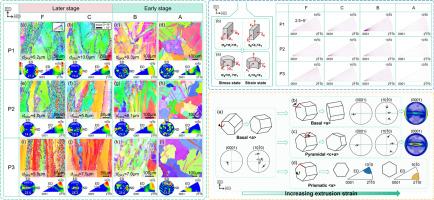挤压AZ31镁合金板双峰晶型组织的异常织构演变
IF 13.8
1区 材料科学
Q1 METALLURGY & METALLURGICAL ENGINEERING
引用次数: 0
摘要
在不同温度和速度下,采用常规挤压法制备了具有双峰晶粒结构的AZ31镁合金板材,研究了动态再结晶和织构演变的机理。虽然所有样品都具有相似的DRXed晶粒尺寸(5.0-6.5µm)和组分(76% - 80%),但它们具有不同的c轴取向和力学性能。P1样品(350°C, 0.1 mm/min)的屈服强度最低(~ 192 MPa),伸长率最高(~ 18.2%),而P3样品(400°C, 0.6 mm/min)的屈服强度最高(~ 241 MPa),伸长率最低(~ 14.2%)。P2样品(400°C, 0.1 mm/min)表现出中间行为(~ 226 MPa, ~ 17.7%)。这些变化主要归因于c轴方向的差异,特别是它们与法向(ND)的对齐以及与挤压方向(ED)的轻微偏差。显微组织分析表明,在不同挤压条件下,不同的DRX机制被激活。P1主要表现为孪生诱导的动态再结晶(TDRX)和连续动态再结晶(CDRX),而P3主要表现为CDRX和不连续动态再结晶(DDRX)。这些DRX机制与受不断变化的局部应力状态控制的激活滑移系统相结合,共同促进了取向旋转和织构发育。在挤压早期,拉伸应变沿着ED促进基底滑移,使c轴向ND方向旋转。随着变形的进行,沿ND方向的压应变占主导地位。在P1中,基底滑移保持活跃,c轴沿ND对齐,与ED形成较小的夹角。相比之下,P3以锥体滑移为主,导致c轴偏离ND明显,相对于ED的夹角略大。P2样品呈现介于P1和P3之间的过渡纹理状态。本文章由计算机程序翻译,如有差异,请以英文原文为准。

Unusual texture evolution in extruded AZ31 Mg alloy plates with bimodal grain structures
AZ31 Mg alloy plates with bimodal grain structures were fabricated via conventional extrusion under varying temperatures and speeds to investigate the mechanisms governing dynamic recrystallization (DRX) and texture evolution. Although all samples exhibited similar DRXed grain sizes (5.0–6.5 µm) and fractions (76 %–80 %), they developed distinct c-axis orientations and mechanical properties. The P1 sample (350 °C, 0.1 mm/min) exhibited the lowest yield strength (∼192 MPa) but the highest elongation (∼18.2 %), whereas the P3 sample (400 °C, 0.6 mm/min) showed the highest yield strength (∼241 MPa) and the lowest elongation (∼14.2 %). The P2 sample (400 °C, 0.1 mm/min) demonstrated intermediate behavior (∼226 MPa, ∼17.7 %). These variations were primarily attributed to differences in c-axis orientations, particularly their alignment with respect to the normal direction (ND) and their slight deviation from the extrusion direction (ED). Microstructural analysis revealed that distinct DRX mechanisms were activated under different extrusion conditions. P1 predominantly exhibited twinning-induced dynamic recrystallization (TDRX) and continuous dynamic recrystallization (CDRX), whereas P3 primarily showed CDRX and discontinuous dynamic recrystallization (DDRX). These DRX mechanisms, in combination with the activated slip systems governed by the evolving local stress state, collectively contributed to orientation rotation and texture development. During the early stage of extrusion, tensile strain along the ED promoted basal <a> slip, rotating the c-axes toward the ND. As deformation progressed, compressive strain along the ND became dominant. In P1, basal <a> slip remained active, aligning the c-axes along the ND and forming a smaller angle with the ED. In contrast, P3 exhibited predominant pyramidal <c + a> slip, resulting in a pronounced deviation of the c-axes from the ND and a slightly larger angle relative to the ED. The P2 sample exhibited a transitional texture state between those of P1 and P3.
求助全文
通过发布文献求助,成功后即可免费获取论文全文。
去求助
来源期刊

Journal of Magnesium and Alloys
Engineering-Mechanics of Materials
CiteScore
20.20
自引率
14.80%
发文量
52
审稿时长
59 days
期刊介绍:
The Journal of Magnesium and Alloys serves as a global platform for both theoretical and experimental studies in magnesium science and engineering. It welcomes submissions investigating various scientific and engineering factors impacting the metallurgy, processing, microstructure, properties, and applications of magnesium and alloys. The journal covers all aspects of magnesium and alloy research, including raw materials, alloy casting, extrusion and deformation, corrosion and surface treatment, joining and machining, simulation and modeling, microstructure evolution and mechanical properties, new alloy development, magnesium-based composites, bio-materials and energy materials, applications, and recycling.
 求助内容:
求助内容: 应助结果提醒方式:
应助结果提醒方式:


